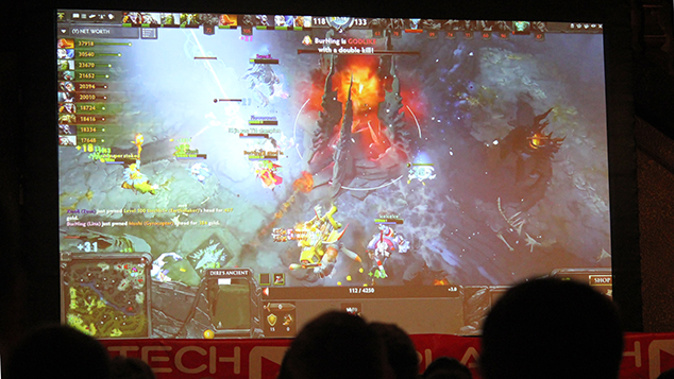
“More people will watch this than the Rugby World Cup.”
So says Rion Roben, co-lead Coordinator for Aspect of Gaming, a local organisation that organises and promotes E-Sports events. The claim, which will sound provocative to many New Zealanders, is being made about the Grand Final of TI5 – otherwise known as The International.
It’s the headline event in the DOTA II circuit, a computer game in which two teams of five players select monsters, battle each other on a large scale map, and attempt the destroy the other team’s base. Played inside the vast KeyArena in Seattle and broadcast online around the world, millions of people will tune in to watch. Other E-Sports are also wildly popular. League of Legends is played by 67 million people a month, and Starcraft is colloquially known as the national sport of South Korea.
The two teams in the TI5 final, CDEC from China and Evil Geniuses from the USA, have battled their way through an intense week of matches to make it. While Evil Genuises are a major brand within the industry, Dota II is yet to take off in the States in quite the same way as it has in China, where it is the 2nd most viewed sport across the entire population.
There’s a local viewing too, with Aspect of Gaming hosting about 200 fans at the Civic Theatre in Auckland. A very young and mostly male audience gaze up at the raised projector screen, huge roars greeting the big moments in play. When questions are asked about why young people seem less interested in traditional sports, the answer may be that they’ve discovered this instead.
While exact figures are difficult to pin down, about 8-10,000 New Zealanders regularly play DOTA II, which is dwarfed by the 4 million who play worldwide every month. The local DOTA II scene is small but highly engaged, described by Aspect of Gaming co-Lead Coordinator Theo Martin as “quite underground.”
“We do a lot of word of mouth. It’s people convincing their friends to come. We’re here to build a community and create an experience for New Zealand gamers.”
While that may make E-Sports sound like a cottage industry, it is anything but. Gaming in all the various forms it takes is now the second largest entertainment medium in the world, and the amount of money on the line at The International is huge. The teams this year played off for a prize pool of approximately $18 million.
They are dizzying sums when the age of the players involved is considered. Top level E-Sports players are generally in their prime in their early 20s, with eyesight and reflexes the most important skills for success. One player involved in the final, Syed Sumail Hassan (codename:Suma1L) from Evil Geniuses, has just turned 16. He’s already a millionaire through his tournament winnings.
Not everyone can do that of course, but there are still thousands who make money off the game. One such player, Lucy Tam (codename: YCULStranger) spends part of her time touring the regional circuit, and part of her time studying nursing at AUT. For her, playing at The International would be “a dream”, and despite being one of the best players in New Zealand it’s a long way out of reach.
The reason for this is the immense commitment required to join the elite. It is here where the comparisons to more traditional sports are ever present. The top DOTA II players are superstars, their entrance into the arena greeted with deafening hype music, reminiscent of professional wrestling. Industry media surrounds their every move. The downside is that to make it a player has to train 8 hours or more a day.
For Rion Roben, the distinction is academic. “They’re both sports from our perspective, it’s just the mainstream hasn’t caught on to E-Sports yet.” He likens it to the growth of animation – which was initially seen as a childish pursuit in most of the world – but thanks to the artistic relevance being given to Japanese anime in particular is now seen as entertainment for all ages.
As the online world becomes more woven into the fabric of everyday life, it is inevitable that E-Sports will continue to grow in profile and popularity. There isn’t yet a Tiger Woods or Michael Jordan to be the worldwide face of E-Sports, but the day when top gamers become household names is surely not far away.
Take your Radio, Podcasts and Music with you









